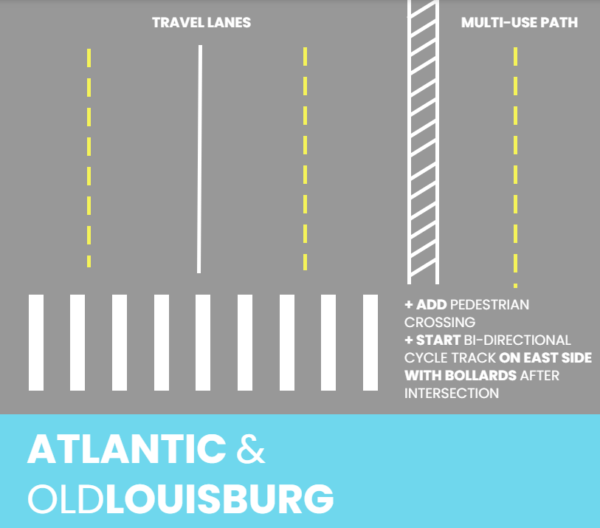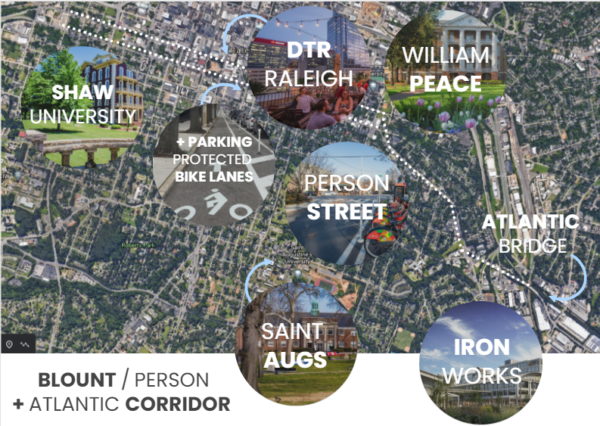
For far too long, a regular sight on the Atlantic Avenue Bridge in Raleigh has been folks walking and biking in mixed traffic, with no sidewalk or bike lane to provide space for them to cross. A small but mighty improvement is planned to come soon – a bike lane is being proposed to finally connect the entire corridor along the bridge from Old Louisburg Road to East Whitaker Mill Road. Given the lack of a sidewalk or any current infrastructure, this is an important improvement to provide space for those on foot or bike to cross.
With significant changes taking place along this corridor and development like the Iron Works project on the eastern side of Atlantic, it is critical that we provide options outside of driving as the only viable transportation option as our community grows. There are small modifications that could be made along this corridor to make it feel safer, and we will work to advocate for the following:
Separation from traffic wherever and whenever possible:
Recognizing that this is a tight corridor with the current configuration of two travel lanes and a turn lane, there are a few changes that could create immediate benefits. Simply adding a vertical separation directly on the painted bike lane, like the installation shown below in Philadelphia on South Street Bridge, would offer an immediate benefit that would not change traffic patterns for those in a vehicle. We do not know of any instances where this application has been done (with no painted buffer) in North Carolina, so it will likely receive pushback, but if other communities are doing this nationally and we know it improves safety along the corridor – it’s vital we commit to doing it and question entities that provide road blocks simply because it has not been done to date. We will literally never see progress unless we are willing to try different treatments to improve walkability and bikability. An extremely low cost option like bollards is the perfect way to try a solution and change it, if needed.
South Street Bridge, Philadelphia (Photo from the Bicycle Coalition of Greater Philadelphia)
More substantial improvements could be made if we were willing to keep the traffic pattern that continues south of the bridge along Wake Forest Road, where there is a north bound and south bound travel lane, and a center turn lane. NCDOT has overbuilt car capacity across the state and it’s vital that advocacy organizations push back on this car centric dialogue and help to ground this discussion to encourage a more equitable stance on how we build, fund and distribute our transportation network. For this to be an all ages and abilities crossing, we must add physical separation from traffic for folks walking and biking in addition to more space.
Additionally, with space available for two 6′ bike lanes, it begs the question – why not just put a 10′ multi-use path on one side of the bridge, with physical separation from traffic. There would need to be modifications made to ensure a safe crossing to get south bound bikes back into the lane, however putting a 10′ multi-use path on the east side of the bridge would allow additional width and spacing for bollards. A crosswalk would need to be added at the base of the bridge (at Old Louisburg Road) but that also begs the question – why isn’t there one there already?

Connecting this installation to All Ages and Abilities Facilities:
We’re not one to normally get excited about painted lanes, but we do think this installation will be a critical connection, and one we can iterate and improve on over time. It’s especially exciting to think about how this bridge has been a pinch point for connectivity and will now literally, bridge, two communities that were previously separated.

If approved by council, these painted lanes will connect the recent improvements on Wake Forest Road as well as connect into long-term plans for separated infrastructure on Atlantic identified in the bike plan. The Blount / Person planning process is currently underway and seeks to improve the bike lanes installed in Phase I. We will be advocating for separated facilities along this corridor as well, and hope to see Phase II become a premier connection in our community to easily allow biking and walking trips through town. With much of the current right of way curb to curb (42’), we could have parking protected bike lanes, 2 travel lanes, and 2 parking lanes along Blount or Person Street. This needs to be the norm for future installations, not something we have to advocate for retroactively to be considered.
For sections tighter than 42’, it makes sense to remove some parking to achieve a separated, parking protected bike lane on one side of the road if that is necessary. That curbside space could be used for additional dining seating, parklets, bike parking, or curb bump outs to allow for safer road crossing options for pedestrians. Up to 40′, you could make small modifications to keep parking on both sides like reducing the buffer to 1′ and the bike lane to 5′. We have got to think more critically about how we use our spaces and ensure all modes have a safe and effective transportation system in place.
What would you like this corridor to look like? Share your thoughts with us and be sure to join the Raleigh Bicycle and Pedestrian Commission meeting (if prompted, password is “walk”) 2/15 at 6pm to hear about the resurfacing project being considered this year, including the bike lanes on the Atlantic Avenue Bridge. See the full agenda here.